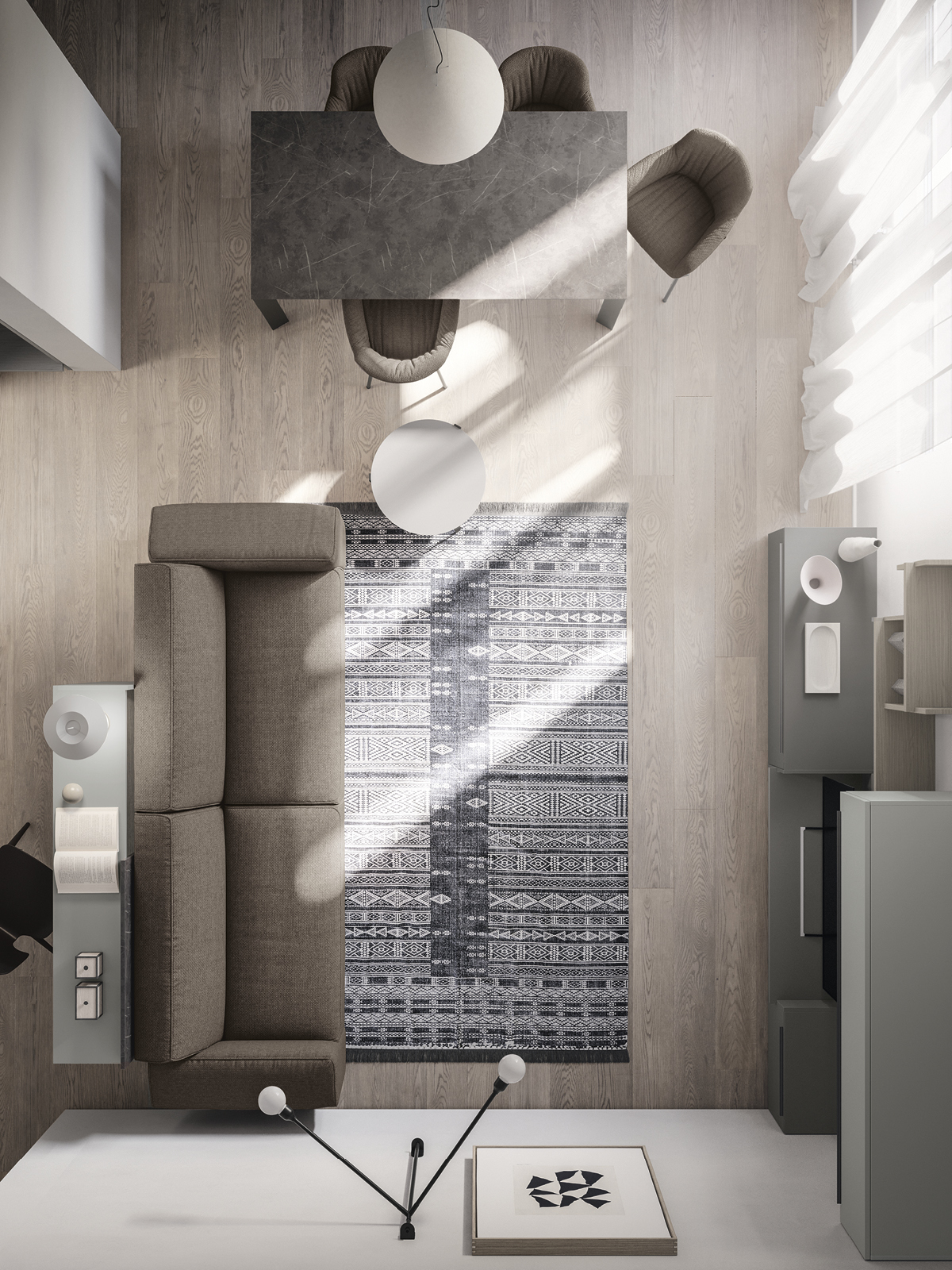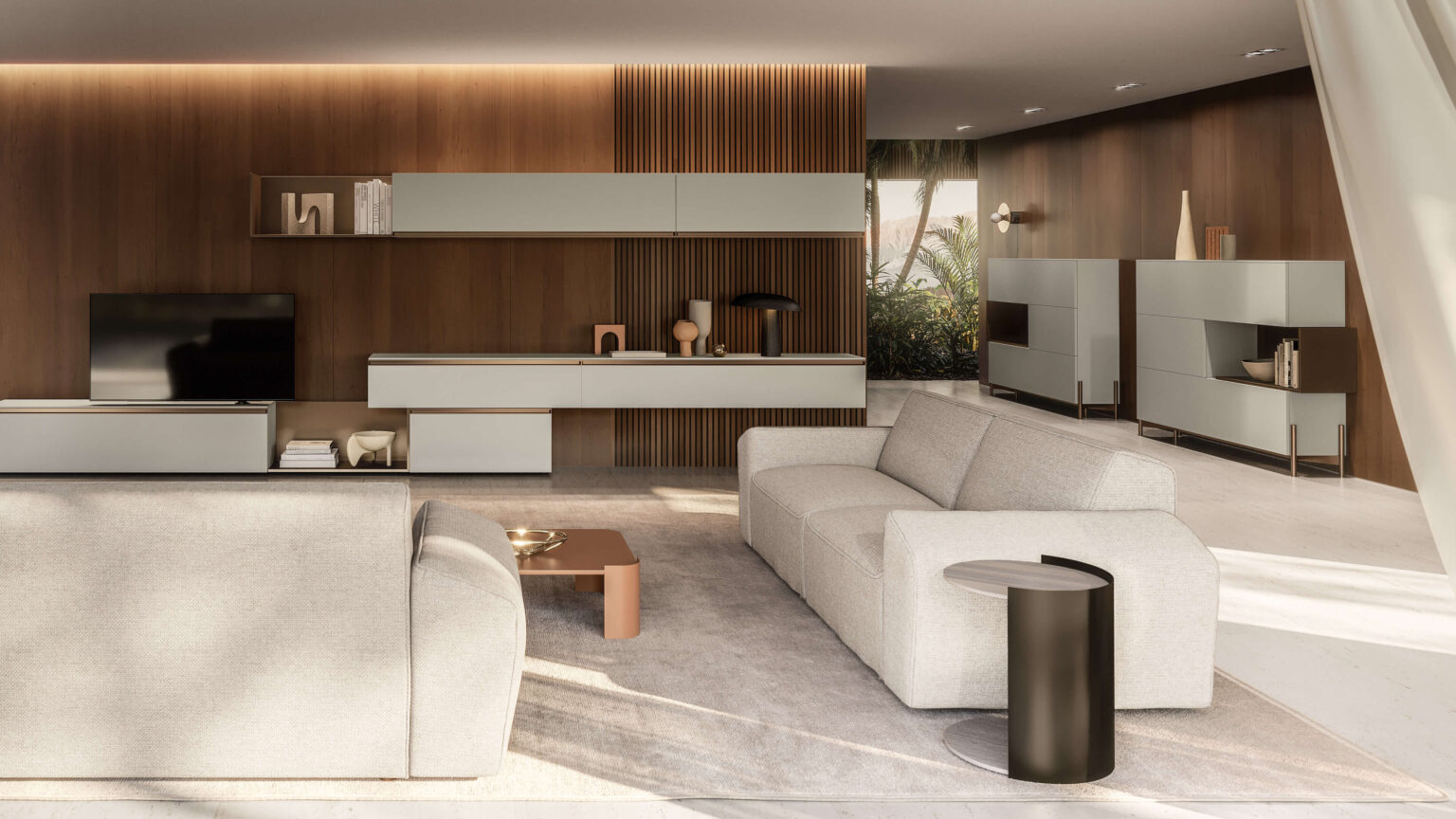Sofa placement: ideas and solutions for every need
Where should the sofa go? When you’re furnishing a modern living room, one fundamental decision is where to place the sofa. It’s a choice that has an impact on the overall aesthetic of the space, but also on functionality. In this article, we explore different ideas and solutions for where to place and how to arrange sofas, taking into account the available space, the function of the sofas, natural light… and even science!

Sofa placement: a matter of science
When you enter a room, the layout of the furniture has an immediate impact on how you experience the space. It’s not only a question of design and aesthetics. There are guiding principles on the optimal layout of furniture, including sofas, which are the key features of many homes. By bringing together concepts from psychology, Feng Shui, ergonomics and visual aesthetics, we can create spaces that are aesthetically pleasing, while also improving our everyday wellbeing.
Design (or environmental) psychology
Where we live and spend our time has an impact on our psychological wellbeing. According to environmental psychology, people tend to feel more at ease in spaces where there is a clear separation between areas for relaxation and areas for other activities. If positioned strategically, a sofa can delimit these spaces and thus help create a sense of order and tranquillity.
Feng Shui
Feng Shui is the ancient Chinese art of harmonising the energy within the home, and it even offers interesting advice about where to place sofas. A sofa facing the main entrance to a room is giving whoever is entering a warm welcome into an inviting space. Also, it’s best to avoid positioning a sofa in the centre of a room. Instead, it should be placed against a wall to ensure the best view and to promote a sense of security. This arrangement promotes the free flow of energy within the space, which helps keep the room open and harmonious, without feeling overcrowded.
Ergonomics and comfort
In addition to psychology and energy, ergonomics also plays an important role in sofa placement. The aim is to create a place where the body can relax completely, without strain or tension. So several factors come into play, like the height, depth and angle of the sofa in relation to other furniture in the room, like occasional tables and TV stands. It’s also important to consider how easy it is to get into and move around the space, to ensure that the experience is comfortable for those using it.
Visual aesthetics
Visual balance is an important part of creating a space that is harmonious and appealing to the eye. The sofa should be a harmonious element within the symmetry of the room, with heavier items balanced by lighter ones and with a uniform distribution of textures and colours. Using sofas as focal points or to define functional areas within an open-plan layout can help create a balanced visual composition that not only welcomes guests at the entrance, but also invites them to interact with and explore the room.

Assess the available space
The first question to ask is: how much space is there? Assessing the size and layout of the room is the first step in understanding where to place the sofa in the living room. Interior designers have two main rules in this regard:
- if the room is large, the sofa can be placed in the centre of it to create an area where you can sit and talk.
- If it’s a smaller room, it’s better to place the sofa against a wall to leave more space in the middle of it.
As always, there are exceptions to these rules. In the case of a small room, it might be necessary to have the TV stand against a wall, with the back of the sofa towards the entrance, as in the photo.

Here, a desk could be added to the back of the sofa to serve as an entrance table. The Evan sofa range by Santalucia Mobili is designed to be multifunctional in any space.
Consider the function of the sofa
The second thing to ask is: how will the sofa be used? If the answer is mainly to watch TV, then the best place for it is in front of the television. But if it’s going to be used as somewhere to sit, talk and spend time together, then it can be placed facing another sofa or some armchairs.
The L-shape configuration in the photo enables the dual function of somewhere to watch TV but also somewhere to sit and chat.

Think about natural light
The third question is: what light sources are there? It is essential to make the most of natural light when choosing a position for a sofa. Place it where it can benefit from the light from windows and create a bright, inviting atmosphere. But don’t position a sofa in front of a window, especially if a large one, to avoid discomfort from direct light.

Choosing the right layout: ideas and inspiration
Choosing where to place a sofa is not just about aesthetics, but also functionality and practicality. Here are some ideas and inspiration for sofa placement.
Against a wall
This is the most classic, common placement for sofas, where the back is against a wall leaving the middle of the room free. And this configuration can be further optimised and enhanced with Santalucia Mobili: with the Evan range, the sofa can be incorporated into one or more bookcases, to create a multifunctional unit combining seating with storage and providing even more options for making the most of the space, including vertically.

Centrepiece sofa
In a large living room, a centrepiece sofa, perhaps alongside a few two- or three-seater sofas, can provide somewhere to sit and chat, or a place to kick back and relax. This is the ideal arrangement in social spaces because it encourages conversation and sharing.

An open-plan living room is also the right setting for a double-sided sofa backed with wood panelling for the addition of upholstered modules, shelves or desks.

L-shaped sofa
A corner sofa creates an inviting cosy atmosphere that is perfect for receiving guests. This configuration delivers several benefits in terms of functionality and comfort. First, placing sofas in this position creates a space that naturally encourages talking and social interaction between the people sitting there.
This arrangement also offers plenty of seating for, say, a large family or a small gathering. With two sofas, everyone can find a comfortable place to sit.
Again, additional elements can be installed, like a comfy dog bed or a practical coffee table for enjoying a drink with friends.

In front of French windows or a glass wall
This placement makes the most of the natural light, creating a bright, airy atmosphere. It particularly suits large, open spaces where it is important to maximise the feeling of space and the connection with the outside.
When the back of a sofa is visible, it’s important to choose a model with a decorative or well-finished rear for an aesthetically appealing look from the other side of the window.
It’s also a good idea to add lightweight curtains or blinds that let in as much natural light as desired and ensure privacy without spoiling the view.

Answers to the most common questions about sofa placement
Where should the sofa go in relation to the main door?
When the living room and the entrance share the same space, it’s important to find creative solutions to optimise the layout of furniture and ensure the space is divided with function in mind.
A sofa with its back to the door can be a strategic way to create a separate area and achieve a degree of privacy in the living room area. In this photo, the sofa creates a visual separation between the entrance and the living room, helping to define the two spaces. To further delimit the living room area and bring an additional decorative element, the Urban room-dividing bookcase is placed behind the sofa.

If the sofa is placed perpendicular to the entrance and there isn’t much space between the door and the furniture, add a desk behind it to provide finish and a handy catchall storage space.

Where should the sofa be placed for watching TV?
Placing the sofa in front of the TV is the best way to ensure an optimal experience in the living room, regardless of whether the room is large or small.

For small rooms, choose a sofa that is proportionate to the space so that the screen can be viewed without compromising comfort and aesthetic design.

Where should the sofa be placed in relation to the table?
One of the ways to arrange the furniture and create a clear, functional division between the dining area and the living room is to place the sofa with its back towards the table, which separates the two areas visually.

Another interesting way to achieve this is by placing a room-dividing bookcase between the table and the back of the sofa. This solution not only provides additional space for books, ornaments and other accessories, but also separates the dining room from the living room. The bookcase serves as a subtle but effective dividing line between the two areas, while adding style and personality to the entire space.

To conclude, sofa placement is not just about aesthetics, but also wellbeing and harmony. By combining design principles, ergonomics and ideas from Feng Shui, you can create an environment where you can feel good and at ease. A careful assessment of the available space, the function of the sofa and natural light will help you achieve a configuration that promotes comfort and a positive flow of energy within the room.
Consider the ideas and solutions presented as a starting point for finding the perfect layout for your personal needs and taste. Sit back and explore our Homy Giorno Moduli and Homy Giorno Details catalogues for even more inspiration.